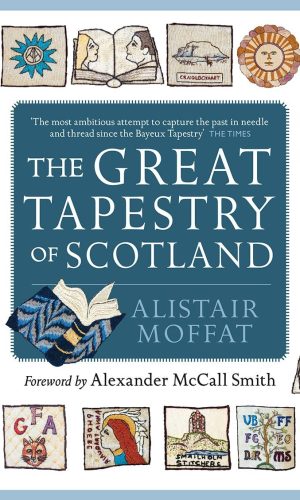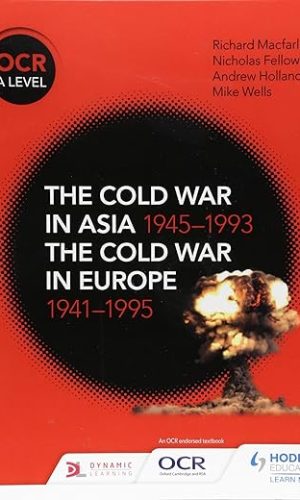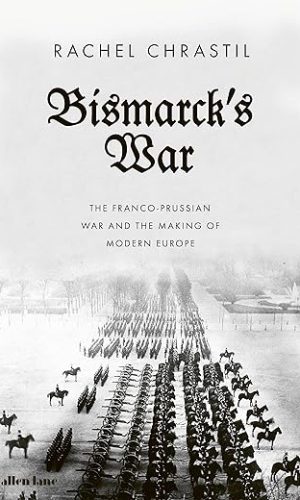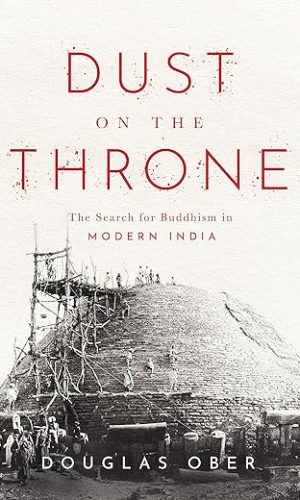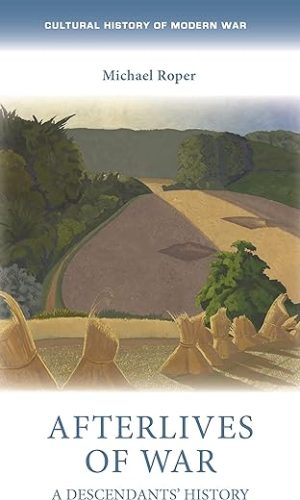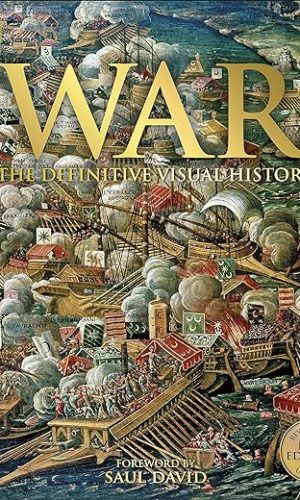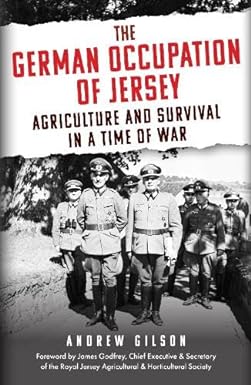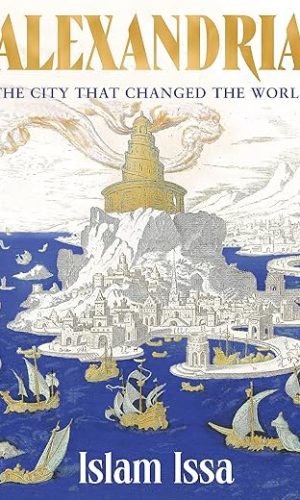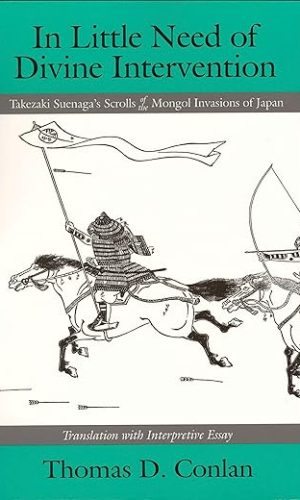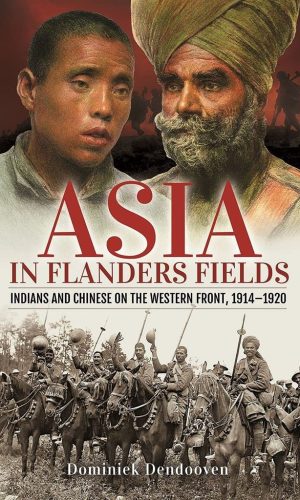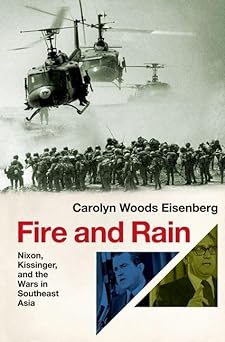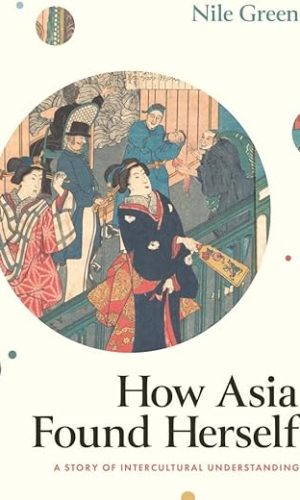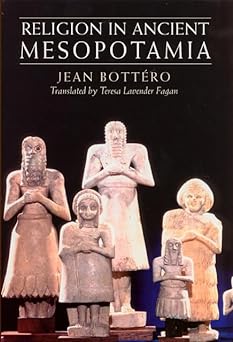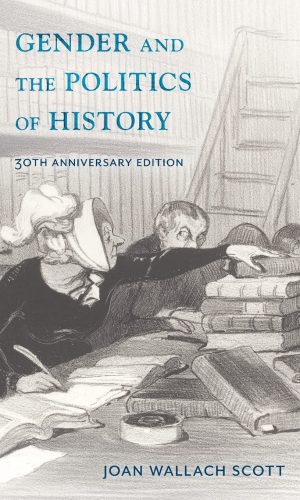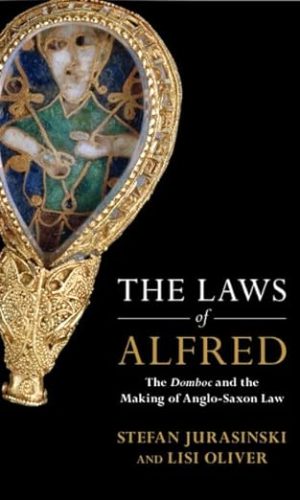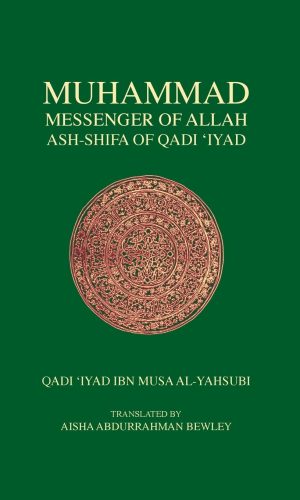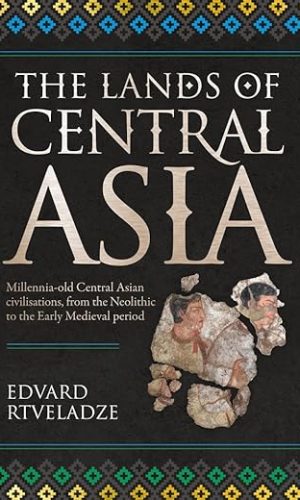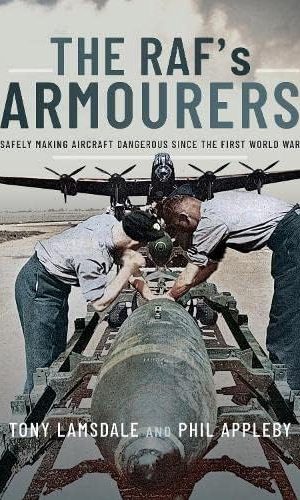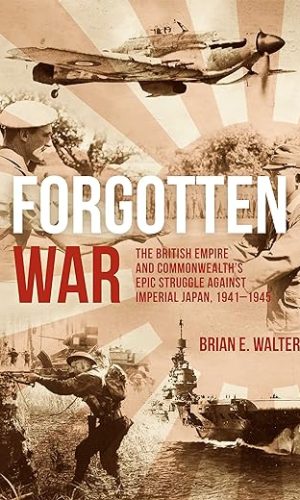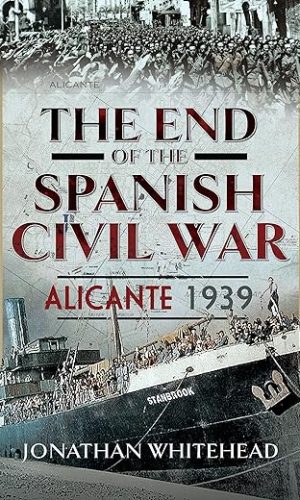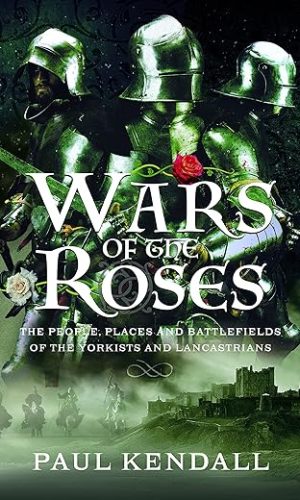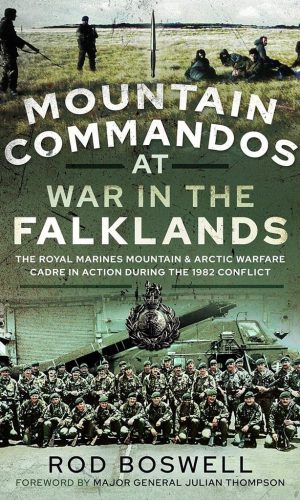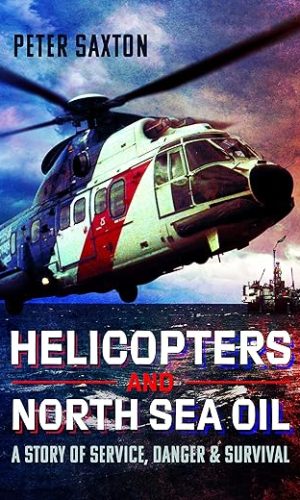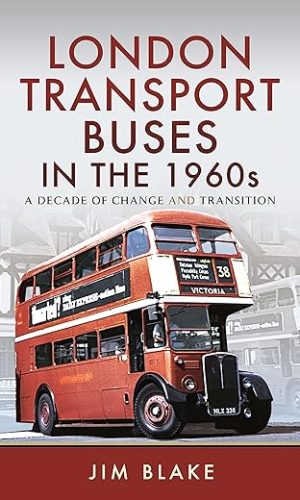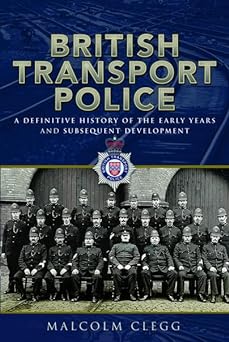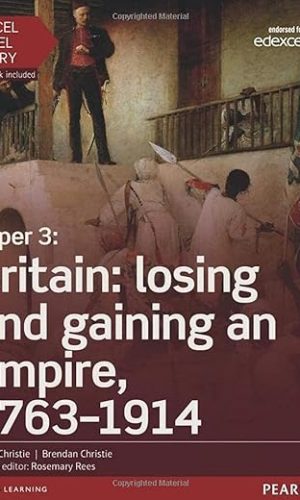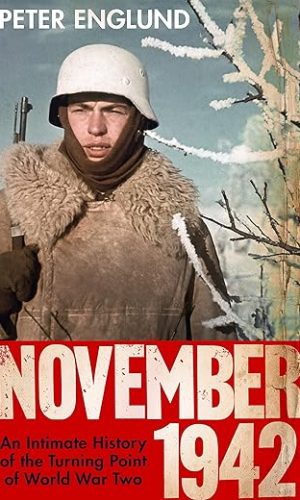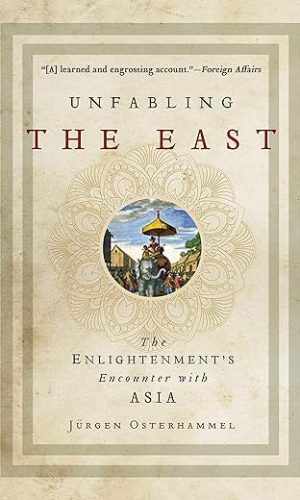-
The Great Tapestry of Scotland
The Great Tapestry of Scotland is an outstanding celebration of thousands of years of Scottish history and achievement, from the end of the last Ice Age to Dolly the Sheep and Andy Murry’s Wimbledon victory of 2013. More than 1000 stitchers spent a total of 55,000 sewing hours on the 160 panels that make up this extraordinary work of art.
This book shows in full colour all the finished panels of the tapestry – one of the biggest community arts projects ever to take place in Scotland – together with descriptive and explanatory material on each panel and lists of all the stitchers involved.
Read more
£25.50£28.50The Great Tapestry of Scotland
£25.50£28.50 -
OCR A Level History: The Cold War in Asia 1945–1993 and the Cold War in Europe 1941–95
Exam board: OCR
Level: A Level
Subject: History
First teaching: September 2015
First exams: AS: Summer 2016, A Level: Summer 2017An OCR endorsed resource
Successfully cover Unit Group 2 with the right amount of depth and pace. This bespoke series from the leading History publisher follows our proven and popular approach for OCR A Level, blending clear course coverage with focused activities and comprehensive assessment support.
– Develops understanding of the period through an accessible narrative that is tailored to the specification content and structured around key questions for each topic
– Builds the skills required for Unit Group 2, from explanation, assessment and analysis to the ability to make substantiated judgements
– Enables students to consolidate and extend their topic knowledge with a range of activities suitable for classwork or homework
– Helps students achieve their best by providing step-by-step assessment guidance and practice questions
– Facilitates revision with useful summaries at the start and end of each chapter
– Ensures that students understand key historical terms and concepts by defining them in the glossary
Read more
£24.70 -
Bismarck’s War: The Franco-Prussian War and the Making of Modern Europe
‘Compassionate and thought-provoking history’ Daily Telegraph
‘Superb on the human consequences of war, ravishing in its evocations of wartime life’ The Times
‘Fresh and compelling … a tour-de-force’ David A. Bell
Less than a month after it marched into France in summer 1870, the Prussian army had devastated its opponents, captured Napoleon III and wrecked all assumptions about Europe’s pecking order. Other countries looked on in helpless amazement. Pushing aside further French resistance, a new German Empire was proclaimed (as a deliberate humiliation) in the Palace of Versailles, leaving the French to face civil war in Paris, reparations and the loss of Alsace and Lorraine.
Bismarck’s War tells the story of one of the most shocking reversals of fortune in modern European history. The culmination of a globally violent decade, the Franco-Prussian War was deliberately engineered by Bismarck, both to destroy French power and to unite Germany. It could not have worked better, but it also had lurking inside it the poisonous seeds of all the disasters that would ravage the twentieth century.
Drawing on a remarkable variety of sources, Chrastil’s book explores the military, technological, political and social events of the war, its human cost and the way that the sheer ferocity of war, however successful, has profound consequences for both victors and victims.
Read more
£24.50£28.50 -
The Dust on the Throne: The Search for Buddhism in Modern India (South Asia in Motion)
Received wisdom has it that Buddhism disappeared from India, the land of its birth, between the thirteenth and fourteenth centuries, long forgotten until British colonial scholars re-discovered it in the early 1800s. Its full-fledged revival, so the story goes, only occurred in 1956, when the Indian civil rights pioneer Dr. B.R. Ambedkar converted to Buddhism along with half a million of his Dalit (formerly “untouchable”) followers. This, however, is only part of the story. Dust on the Throne reframes discussions about the place of Buddhism in the subcontinent from the early nineteenth century onwards, uncovering the integral, yet unacknowledged, role that Indians played in the making of modern global Buddhism in the century prior to Ambedkar’s conversion, and the numerous ways that Buddhism gave powerful shape to modern Indian history.
Through an extensive examination of disparate materials held at archives and temples across South Asia, Douglas Ober explores Buddhist religious dynamics in an age of expanding colonial empires, intra-Asian connectivity, and the histories of Buddhism produced by nineteenth and twentieth century Indian thinkers. While Buddhism in contemporary India is often disparaged as being little more than tattered manuscripts and crumbling ruins, this book opens new avenues for understanding its substantial socio-political impact and intellectual legacy.
Read more
£24.00£26.60 -
Afterlives of War: A Descendants’ History (Cultural History of Modern War)
Afterlives of war documents the lives and historical pursuits of the generations who grew up in Australia, Britain and Germany after the First World War. Although they were not direct witnesses to the conflict, they experienced its effects from their earliest years. Based on ninety oral history interviews and observation during the First World War Centenary, this pioneering study reveals the contribution of descendants to the contemporary memory of the First World War, and the intimate personal legacies of the conflict that animate their history-making.Read more
£23.80 -
War: The Definitive Visual History
Follow the epic 5,000-year story of warfare – from the earliest battles to the War on Terror – with this guided tour of every major conflict.
Combining a clear and compelling historical narrative with a wealth of fascinating eyewitness accounts and photography throughout, this is the ultimate guide to the history of military conflict, from the armies of ancient
Egypt to the rise of Isis in Syria and Iraq, and the ongoing Yemeni civil war.War explores the battles, the warriors, the tactics, and the weapons and technology that have shaped conflict worldwide. Lavishly illustrated with paintings, photographs, artefacts, and maps, this book offers a uniquely detailed and visually rich view of all major aspects of human conflict.
Whether on the bloody battlefields of the ancient world or in the modern era of drones and laser-guided missiles, this is the complete story of the wars that have shaped our world.
Read more
£23.80£28.50War: The Definitive Visual History
£23.80£28.50 -
The German Occupation of Jersey: Agriculture and Survival in a Time of War
On 1 July 1940 the Germans occupied Jersey and remained until the end of the war in Europe in May 1945. On Jersey, agriculture was the only economic activity left after the Germans arrived on the Island. It became the basis of Island life and, as the war wore on, the isolated Jersey became increasingly dependent on agriculture for its survival, particularly during near starvation in the winter of 1944. In this book local historian Andrew Gilson examines the relationship between the German Military Government and the civilian government and civil service on Jersey, and how they had to work together to ensure the Island’s survival through its farming industry. Based on hundreds of original documents from Jersey, including those held by the Royal Jersey Agricultural & Horticultural Society, other Channel Islands, Germany, France, Austria and elsewhere in Europe, the author reveals the complex relationship between the German occupiers, civilian authorities and the farming community. Accusations of collaboration and stories of sabotage, German exports of produce, the development of tobacco as a cash economy, the exploitation of Jersey cattle by Nazi scientists to create a new ‘superbreed’, German requisition of foodstuffs and the black market all played their part in this fascinating story. This groundbreaking and original study of the German occupation of Jersey will be of interest to all those wishing to know more about the history of Jersey as well as to military historians.Read more
£23.70£28.50 -
Alexandria: The City that Changed the World: ‘Monumental’ – Daily Telegraph
‘Monumental and vividly imagined . . . a fitting tribute to a city that has survived, changed and grown for so many centuries’
Daily Telegraph‘A cornucopia of fascinating details, every page revealing a new delight’
Paul Strathern, author of The Medici: Godfathers of the RenaissanceA city drawn in sand.
Inspired by the tales of Homer and his own ambitions of empire, Alexander the Great sketched the idea of a city onto the sparsely populated Egyptian coastline. He did not live to see Alexandria built, but his vision of a sparkling metropolis that celebrated learning and diversity was swiftly realised and still stands today.
Situated on the cusp of Africa, Europe and Asia, great civilisations met in Alexandria. Together, Greeks and Egyptians, Romans and Jews created a global knowledge capital of enormous influence: the inventive collaboration of its citizens shaped modern philosophy, science, religion and more. In pitched battles, later empires, from the Arabs and Ottomans to the French and British, laid claim to the city but its independent spirit endures.
In this sweeping biography of the great city, Islam Issa takes us on a journey across millennia, rich in big ideas, brutal tragedies and distinctive characters, from Cleopatra to Napoleon. From its humble origins to dizzy heights and present-day strife, Alexandria tells the gripping story of a city that has shaped our modern world.
‘A multifaceted history of an enthralling city’
Lloyd Llewellyn-Jones, author of Persians: The Age of the Great KingsRead more
£23.70£28.50 -
In Little Need of Divine Intervention: Takezaki Suenaga’s Scrolls of the Mongol Invasions of Japan: 113 (Cornell East Asia)
In Little Need of Divine Intervention presents a fundamental revision of the thirteenth-century Mongol Invasions of Japan by revealing that the warriors of medieval Japan were capable of fighting the Mongols to a standstill without the aid of any “divine winds” or kamikaze. Conlan’s interpretation of the invasions is supplemented with translations of the picture scrolls commissioned by Takezaki Suenaga, a warrior who fought against the Mongols. In addition, translations of nearly seventy administrative documents are provided, thereby enabling students of Japanese history reconstruct the invasions using contemporary sources. A rare copy of Takezaki Suenaga’s Scrolls, reproduced in full, reveals hitherto unknown missing scenes. Furthermore, the scrolls’ images can be now read in tandem with its narrative passages, translated in English for the first time. Please note that the entire book was intentionally printed from back to front, so that the reproduced scrolls unfold in Japanese order, from right to left. Thus the book’s spine is on the right. This monograph will prove to be of great interest for students and scholars of medieval Japanese history, warrior culture, and the nature of Japan in an East Asian context.
Read more
£23.70 -
Asia in Flanders Fields: Indians and Chinese on the Western Front, 1914 1920
The First World War brought peoples from five continents to support the British and French Allies on the Western Front. Many were from colonial territories in the British and French empires, and the largest contingents were Indians and Chinese – some 140,000. It is a story of the encounter with the European ‘other’, including the civilian European local populations, often marred by racism, discrimination and zenophobia both inside and outside the military command, but also lightened by moving and enduring ‘human’ social relationships. The vital contribution to the Alles and the huge sacrifices involved were scarcely recognised at the Paris Peace Conference in 1918 or the post-war victory celebrations and this led to resentment – see huge media coverage in 2021. The effect of the European ‘other’ experience enhanced Asian political awareness and self-confidence, and stimulated anti-imperialism and proto-nationalism. This is a vivid and original contribution to imperial decline from the First World War. and the originality of the work is enhanced by rare sources culled from original documents and ‘local’ European fieldwork – in French, German and Flemish.Read more
£23.70 -
The Middle East: A Political History from 395 to the Present
The Middle East, often referred to as the cradle of the three monotheisms, is saturated with symbolism. Situated at the crossroads of Asia, Africa, and Europe, it is a land marked by the rich confluence of religions and peoples. It has also been the focal point of endemic tensions and conflicts, many of which stretch back into the mists of time.
In this new history of the Middle East, Jean-Pierre Filiu looks beyond religion and focuses his attention on the processes by which powers and their areas of domination were established over time. His starting point is 395, the year when the Roman Empire was divided into eastern and western halves: at that point, the Middle East emerged as a specific entity, freed from external domination, and a Christianity of the East asserted itself, turned towards Byzantium rather than towards Rome. From this point on, Filiu follows a strictly Middle Eastern dynamic, tracing the rise and fall of powers linked to the three principal centres of Egypt, Syria, and Iraq and recounting the procession of empires, invasions, and assertions of imperialist ambition that have characterized the region since then. The book closes in 2022, when the men and women of the Middle East were still struggling for the right to define their destiny by telling their stories in their own voices.
This magisterial and up-to-date history of the Middle East will be essential reading for students and scholars and for anyone interested in the history and politics of one of the most important and contested regions of the modern world.
Read more
£23.70£28.50 -
Fire and Rain: Nixon, Kissinger, and the Wars in Southeast Asia
This gripping account interweaves Nixon and Kissinger’s pursuit of the war in Southeast Asia and their diplomacy with the Soviet Union and China with on-the-ground military events and US domestic reactions to the war conducted in Vietnam, Laos, and Cambodia.Fire and Rain is a compelling, meticulous narrative of the way national security decisions formed at the highest levels of government affect the lives of individuals at home and abroad. By drawing these connections, Carolyn Woods Eisenberg brings to life policy decisions about Vietnam, Laos, and Cambodia, conveying their significance to a new generation of readers. She breaks fresh ground in contextualizing Richard Nixon and Henry Kissinger’s decisions within a wider institutional and societal framework. While recognizing the distinctive personalities and ideas of these two men, this study more broadly conveys the competing roles and impact of the professional military, the Congress, and a mobilized peace movement.
Drawing upon a vast collection of declassified documents, Eisenberg presents an important re-interpretation of the Nixon Administration’s relations with the Soviet Union and China vis a vis the war in Southeast Asia. She argues that in their desperate effort to overcome, or at least overshadow, their failure in Vietnam, Nixon and Kissinger made major concessions to both nations in the field of arms control, their response to the India-Pakistan war, and the diplomacy surrounding Taiwan–much of this secret. Despite policymakers’ claims that the Vietnam War was a “national security” necessity that would demonstrate American strength to the communist superpowers and “credibility” to friendly governments, the historical record suggests a different reality.
A half-century after the Paris Peace Conference marking the withdrawal of US troops and advisors from Vietnam and foreign troops from Laos and Cambodia, Fire and Rain is a dramatic account of geopolitical decision making, civil society, and the human toll of the war on the people of Southeast Asia.
Read more
£23.10£24.70 -
How Asia Found Herself: A Story of Intercultural Understanding
A pioneering history of cross-cultural knowledge that exposes enduring fractures in unity across the world’s largest continentThe nineteenth century saw European empires build vast transport networks to maximize their profits from trade, and it saw Christian missionaries spread printing across Asia to bring Bibles to the colonized. The unintended consequence was an Asian communications revolution: the maritime public sphere expanded from Istanbul to Yokohama. From all corners of the continent, curious individuals confronted the challenges of studying each other’s cultures by using the infrastructure of empire for their own exploratory ends. Whether in Japanese or Persian, Bengali or Arabic, they wrote travelogues, histories, and phrasebooks to chart the vastly different regions that European geographers labeled “Asia.”
Yet comprehension does not always keep pace with connection. Far from flowing smoothly, inter-Asian understanding faced obstacles of many kinds, especially on a landmass with so many scripts and languages. Here is the dramatic story of cross-cultural knowledge on the world’s largest continent, exposing the roots of enduring fractures in Asian unity.Read more
£23.00£23.80 -
Religion in Ancient Mesopotamia
One of the world’s foremost experts on Assyriology, Jean Bottéro has studied the religion of ancient Mesopotamia for more than fifty years. Building on these many years of research, Bottéro here presents the definitive account of one of the world’s oldest known religions. He shows how ancient Mesopotamian religion was practiced both in the public and private spheres, how it developed over the three millennia of its active existence, and how it profoundly influenced Western civilization, including the Hebrew Bible.
Read more
£22.80 -
Boom Cities: Architect Planners and the Politics of Radical Urban Renewal in 1960s Britain
Boom Cities is the first published history of the profound transformations of British city centres in the 1960s.It has often been said that urban planners did more damage to Britain’s cities than even the Luftwaffe had managed, and this study details the rise and fall of modernist urban planning, revealing its origins and the dissolution of the cross-party consensus, before the ideological smearing that has ever since characterized the high-rise towers, dizzying ring roads, and concrete precincts that were left behind.
The rebuilding of British city centres during the 1960s drastically affected the built form of urban Britain, including places ranging from traditional cathedral cities through to the decaying towns of the industrial revolution. Boom Cities uncovers both the planning philosophy, and the political, cultural, and legislative background that created the conditions for these processes to occur across the country.
Boom Cities reveals the role of architect-planners in these transformations. The volume also provides an unconventional account of the end of modernist approaches to the built environment, showing it from the perspective of planning and policy elites, rather than through the emergence of public opposition to planning.
Read more
£22.60 -
Gender and the Politics of History (Gender and Culture Series)
This landmark work from a renowned feminist historian is a foundational demonstration of the uses of gender as a conceptual tool for cultural and historical analysis. Joan Wallach Scott offers a trenchant critique of the compartmentalization of women’s history, arguing that political and social categories are always fundamentally shaped by gender and that questions of gender are essential to considerations of difference in history. Exploring topics ranging from language and class to the politics of work and family, Gender and the Politics of History is a vital contribution to feminist history and historical methodology that also speaks more broadly to the ongoing redefinition of gender in our political and cultural vocabularies.This anniversary edition of a classic text in feminist theory and history shows the evergreen relevance of Scott’s work to the humanities and social sciences. In a new preface, Scott reflects on the book’s legacy and implications for contemporary politics as well as what she has reconsidered as a result of her engagement with psychoanalytic theory. The book also includes a previously unpublished essay, “The Conundrum of Equality,” which takes up the question of affirmative action.
Read more
£22.40£23.80 -
The Laws of Alfred: The Domboc and the Making of Anglo-Saxon Law (Studies in Legal History)
Alfred the Great’s domboc (‘book of laws’) is the longest and most ambitious legal text of the Anglo-Saxon period. Alfred places his own laws, dealing with everything from sanctuary to feuding to the theft of bees, between a lengthy translation of legal passages from the Bible and the legislation of the West-Saxon King Ine (r. 688–726), which rival his own in length and scope. This book is the first critical edition of the domboc published in over a century, as well as a new translation. Five introductory chapters offer fresh insights into the laws of Alfred and Ine, considering their backgrounds, their relationship to early medieval legal culture, their manuscript evidence and their reception in later centuries. Rather than a haphazard accumulation of ordinances, the domboc is shown to issue from deep reflection on the nature of law itself, whose effects would permanently alter the development of early English legislation.Read more
£21.80 -
Forbidden Signs: American Culture and the Campaign against Sign Language
Forbidden Signs explores American culture from the mid-nineteenth century to 1920 through the lens of one striking episode: the campaign led by Alexander Graham Bell and other prominent Americans to suppress the use of sign language among deaf people.The ensuing debate over sign language invoked such fundamental questions as what distinguished Americans from non-Americans, civilized people from “savages,” humans from animals, men from women, the natural from the unnatural, and the normal from the abnormal. An advocate of the return to sign language, Baynton found that although the grounds of the debate have shifted, educators still base decisions on many of the same metaphors and images that led to the misguided efforts to eradicate sign language.
“Baynton’s brilliant and detailed history, Forbidden Signs, reminds us that debates over the use of dialects or languages are really the linguistic tip of a mostly submerged argument about power, social control, nationalism, who has the right to speak and who has the right to control modes of speech.”—Lennard J. Davis, The Nation
“Forbidden Signs is replete with good things.”—Hugh Kenner, New York Times Book Review
Read more
£21.70 -
Atlas de Paris au Moyen-Age 2018: Espace urbain, habitat, société, religion et lieux de pouvoir
Paris ― 200 000 habitants en 1300 ― est la plus grande ville de l’Occident médiéval. Elle devient au xIIIe siècle la capitale du puissant royaume de France vers laquelle affluent intellectuels, hommes d’affaires et artistes. La croissance sans précédent de la cité n’a pas manqué de laisser une empreinte durable. Dans bien des quartiers, le tracé actuel des rues reflète les opérations de lotissement qui présidèrent à l’installation des nouveaux venus au cours du Moyen Age. Si peu d’édifices médiévaux sont aujourd’hui visibles dans leur quasi-intégrité, telles Notre-Dame ou la Sainte-Chapelle, beaucoup sont conservés de manière fragmentaire, comme le Louvre de Philippe Auguste, la salle des gens d’armes de la Conciergerie ou le réfectoire du couvent des Cordeliers. Ces vestiges ― et bien d’autres ― jalonnent la trame urbaine dont les aspects changeant au fil d’un millénaire sont restitués par les images anciennes. Entre la “ville idéale” rêvée par les rois et la cité grouillante aux maisons serrées les unes contre les autres, aux ruelles étroites et nauséabondes, se dessine le visage du Paris médiéval.Read more
£21.20 -
Hitler, Stalin, Mum and Dad: A Family Memoir of Miraculous Survival
THE INSTANT SUNDAY TIMES BESTSELLER
‘Epic, moving and important’ ROBERT HARRIS
‘A modern classic’ OBSERVER
‘An unforgettable epic of a book’DAILY MAIL
From longstanding political columnist and commentator Daniel Finkelstein, a powerful memoir exploring both his mother and his father’s devastating experiences of persecution, resistance and survival during the Second World War.
Daniel’s mother Mirjam Wiener was the youngest of three daughters born in Germany to Alfred and Margarete Wiener. Alfred, a decorated hero from the Great War, is now widely acknowledged to have been the first person to recognise the existential danger Hitler posed to the Jews and began, in 1933, to catalogue in detail Nazi crimes. After moving his family to Amsterdam, he relocated his library to London and was preparing to bring over his wife and children when Germany invaded the Netherlands. Before long, the family was rounded up, robbed and sent to starve in Bergen-Belsen.
Daniel’s father Ludwik was born in Lwów, the only child of a prosperous Jewish family. In 1939, after Hitler and Stalin carved up Poland, Ludwik’s father was arrested and sentenced to hard labour in the Gulag. Meanwhile, deported to Siberia and working as a slave labourer on a collective farm, Ludwik survived the freezing winters in a tiny house he built from cow dung.
Hitler, Stalin, Mum and Dad is a deeply moving, personal and at times horrifying memoir about Finkelstein’s parents’ experiences at the hands of the two genocidal dictators of the twentieth century. It is a story of persecution; survival; and the consequences of totalitarianism told with the almost unimaginable bravery of two ordinary families shining through.
‘Danny Finkelstein has written an elegant, moving account of the history of one family, and in doing so shines light on the history of the 20th century. If you want to understand Hitler and Stalin, read this book about people whose lives were upended by both of them’ ANNE APPLEBAUM, author of Gulag: A History, winner of the Pulitzer Prize
Daniel Finkelstein’s book ‘Hitler, Stalin, Mum and Dad’ was a Sunday Times bestseller w/c 26-06-2023.
Read more
£20.99£25.00 -
Muhammad Messenger of Allah
Kitab Ash-Shifa bi ta’rif huquq al-Mustafa, (Healing by the recognition of the Rights of the Chosen One), of Qadi ‘Iyad (d. 544H/1149CE) is perhaps the most frequently used and commented upon handbook in which the Prophet’s, may Allah bless him and grant him peace, life, his qualities and his miracles are described in every detail. Generally known by its short title, Ash-Shifa, this work was so highly admired throughout the Muslim world that it soon acquired a sanctity of its own for it is said: “If Ash-Shifa is found in a house, this house will not suffer any harm… when a sick person reads it or it is recited to him, Allah will restore his health.” Ash-Shifa gathers together all that is necessary to acquaint the reader with the true stature of the Prophet, may Allah bless him and grant him peace, with the esteem and respect which is due to him, and with the verdict regarding anyone who does not fulfil what his stature demands or who attempts to denigrate his supreme status – even by as much as a nail paring.
Read more
£20.90£39.90Muhammad Messenger of Allah
£20.90£39.90 -
Brotherhood: When West Point Rugby Went to War
“We’re better off for having these men among us.”—Wall Street Journal
Before 9/11, the rugby team at West Point learned to bond on a sports field. This is what happened when those 15 young men became leaders in war.
Filled with drama, tragedy, and personal transformations, this is the story of a unique brotherhood. It is a story of American rugby and a story of the U. S. Army created through intimate portraits of men shaped by West Point’s motto: “Duty, Honor, Country.”
Some of the players deployed to Afganistan and Iraq, some to Europe. Some became infantry, others became fliers. Some saw action, some did not. One gave his life on a street in Baghdad when his convoy was hit with an IED. Two died away from the battlefield but no less tragically.
Journalist Martin Pengelly, a former rugby player himself, was given extraordinary access to tell this story, a story of a brutal sport and even more brutal warfare.
Read more
£20.90 -
Jewish Fundamentalism in Israel – New Edition (Pluto Middle Eastern Studies S)
‘Illuminative, insightful and accessible, this is an important book that deserves as wide a readership as possible.’ Ethnic Conflict Research Digest ‘A first-class overview of the different fundamentalist movements . . . A fascinating and thought-provoking book.’ Neue Zurcher Zeitung (Switzerland) ‘Shahak and Mezvinsky’s explicit objective is to rouse the reader, particularly the North American reader, into an acknowledgement that Jewish fundamentalism is as ‘pernicious’ as other fundamentalisms. This requires us to approach the Jewish past not as folk-tale, but as history.’ Outlook ‘Unlike all other English-language accounts [this] is frank and fiercely critical . . . A must-read for anyone interested in exploring the dark corners of an ideology that has an impact on international events.’ Race and Class This is a new edition of a classic and highly controversial book that examines the history and consequences of Jewish Fundamentalism in Israel. Fully updated, with new chapters and a new introduction by Norton Mezvinsky, it is essential reading for anyone who wants a full understanding of the way religious extremism has affected the political development of the modern Israeli state. Acclaimed writer and human rights campaigner Israel Shahak was, up util his death in 2001, one of the most respected of Israel’s peace activists – he was, in the words of Gore Vidal, ‘the latest – if not the last – of the great prophets.’ Written by Shahak together with American scholar Norton Mezvinsky, this books shows how Jewish fundamentalism in Israel, as shown in the activities of religious settlers, is of great political importance. The authors trace the history and development of Jewish fundamentalism. They place the assassination of Prime Minister Rabin in the context of what they see as a tradition of punishments and killings of those Jews perceived to be heretics. They conclude that Jewish fundamentalism is essentially hRead more
£20.90 -
The Lands of Central Asia: Millennia-old Central Asian civilisations, from the Neolithic to the Early Medieval Period
- A comprehensive guide for those seeking to understand the rich cultural heritage of Central Asia
- The most authoritative single-volume treatment of the long history of Central Asia
- With all new colour plates in a beautiful hardback edition, this book seeks to bring Central Asia’s illustrious history to life for a new international audience
A comprehensive guide for those seeking to understand the rich cultural heritage of Central Asia, this book is the most authoritative single-volume treatment of the region’s long history. This newly translated volume investigates the civilisations and states which emerged in Central Asia from the Bronze Age up to the 5th century AD. It examines their differing religions and cultures and explores their changing relationships over time. With all new colour plates in a beautiful hardback edition, this book seeks to bring Central Asia’s illustrious history to life for a new international audience.
Read more
£20.70£23.80 -
The RAF’s Armourers: Safely Making Aircraft Dangerous Since the First World War
It is said that one of the earliest trades in the world is that of the Armourer. Historically, it is a profession dated slightly after prostitution, but well before banking! Since the birth of the Royal Flying Corps in 1912 through to the modern Royal Air Force, the role of the Armourer has been pivotal. Not for nothing did the founder of the RAF, Lord Trenchard, once declare: The Armourer – without him there is no need for an air force.’ In the years since the need for RAF Armourers was first recognised, it has been a role that has evolved with the times. What has remained constant, however, is the fact that it is still a fascinating and potentially dangerous trade with many different branches and specialisms. In this book the authors, one of whom, Tony Lamsdale, is himself a former RAF Armourer, reveal the previously untold story of how the trade has adapted to the most modern of military machines, the aircraft. The authors look at the shared history of the Armourer and the RAF through the eyes of those who served. These veterans’ stories span decades, and their first-hand accounts and insights into conflict and peace-time operations demonstrate the qualities and characteristics that make Armourers unique. The book starts with a brief history of the Armourer, then before capturing the adventures and exploits of RAF Armourers from the Second World War and on into the Cold War. The dangerous duties of the Armourers on deployment in such places as the Falklands, Iran, Iraq or Afghanistan are all explored. There is also the question of having to learn of bomb dumps, the use of small arms and the unique world of the Armourer with its own peculiar language and the camaraderie of the crew room. With each chapter brought to life through personal anecdotes and shared experiences, this book provides an insight into an utterly essential role which has remained largely hidden – until now.Read more
£20.30£26.60 -
Forgotten War: The British Empire and Commonwealth’s Epic Struggle Against Imperial Japan, 1941–1945
The monumental struggle fought against Imperial Japan in the Asia/Pacific theater during World War II is primarily viewed as an American affair. While the United States did play a dominant role, the British and Commonwealth forces also made major contributions – on land, at sea and in the air – eventually involving over a million men and vast armadas of ships and aircraft. It was a difficult and often desperate conflict fought against a skilled and ruthless enemy that initially saw the British suffer the worst series of defeats ever to befall their armed forces. Still, the British persevered and slowly turned the tables on their Japanese antagonists. Fighting over an immense area that stretched from India in the west to the Solomon Islands in the east and Australia in the south to the waters off Japan in the north, British and Commonwealth forces eventually scored a string of stirring victories that avenged their earlier defeats and helped facilitate the demise of the Japanese Empire.Often overlooked by history, this substantial war effort is fully explored in Forgotten War. Meticulously researched, the book provides a complete, balanced and detailed account of the role that British and Commonwealth forces played on land, sea and in the air during this crucial struggle. It also provides unique analysis regarding the effectiveness and relevance of this collective effort and the contributions it made to the overall Allied victory.
Read more
£20.10£23.80 -
The End of the Spanish Civil War: Alicante 1939
The Spanish Civil War ended in Alicante. After Catalonia fell to the Hitler and Mussolini backed military rebellion of Franco’s Nationalists at the outset of 1939, the legitimate Republican government of Dr Negrín was faced with a choice between apparently futile resistance or unconditional surrender to the triumphant Nationalists. Choosing the path of continued defiance until they could force concessions or at least implement a mass evacuation of those Republicans most at risk in Franco’s new Spain, the government withdrew to Elda in the province of Alicante. However, their plans were thwarted by a new rebellion of Republican officers, led by Colonel Segismundo Casado, who resented Negrín’s reliance on the Communist Party and the USSR and believed themselves better equipped to negotiate a peace settlement with Franco. They were misguided, Franco had no wish, and ultimately no need to negotiate. Meanwhile, faced with the imminent risk of arrest by the new junta, the Prime Minister and his cabinet were forced to abandon Spain from the tiny aerodrome of Monóvar. A relatively quiet port on the eastern, Mediterranean coast of Spain, Alicante had remained at some distance from the frontlines throughout the fighting on the ground, but swiftly became a target for Italian bombers operating out of bases in the Balearic Islands. In May 1938, at the height of the air offensive, Italian bombers attacked the marketplace, causing a massacre as tragic as the events in Guernica, yet largely ignored by historians. As the war drew towards its conclusion, Alicante became increasingly significant as attention focused on the plight of the defeated Republicans. In the second half of March 1939, the fronts collapsed, and Madrid finally fell to the insurgents. Tens of thousands of refugees descended on Alicante in the forlorn hope of rescue by French and British ships that had been promised but which failed to materialise. Amid the tragedy, as the British and French governments declined to engage in any humanitarian intervention that might offend Hitler and Mussolini, a single hero emerged; Captain Archibald Dickson, the Welsh master of the Stanbrook who ditched his cargo and transported 3,000 refugees to safety in North Africa. On 30 March 1939, Franco’s vanguard, the Italian ‘Volunteer’ Corps under General Gastone Gambara, occupied a town already under the control of the Fifth Column. Two days later the Generalísimo issued a communiqué from his headquarters in Burgos, declaring that the war was over. The bulk of the Republicans surrounded and captured in the port were marched to an improvised internment camp, known as the Campo de los Almendros (Field of Almond Trees). They were then transferred to the infamous concentration camp at Albatera to share the fate of defeated Republicans across Spain and to undergo the programme of ideological cleansing of the new fascist authorities.Read more
£20.00£23.80The End of the Spanish Civil War: Alicante 1939
£20.00£23.80 -
Wars of the Roses: The People, Places and Battlefields of the Yorkists and Lancastrians
The Wars of the Roses, which saw England and Wales ravaged by warfare for three decades and dynasties rise and fall, decimated the nobility of an entire generation, and saw the rise of the merchant class, the decline of medieval feudalism and opened the country to the enlightened ideals of the Renaissance. Such has been its lasting effects the red and white rose of the Tudors is still a national symbol. This book is an exploration of the buildings, monuments, towns and battlefields of that turbulent era across both England and Wales – places that can still be visited and experienced today. The stories of the great battles of St Albans, Stoke Field, Wakefield, Townton, Barnet, Tewksbury and, of course, Bosworth, are told along with beautiful photographs to help guide the reader round these important sites, as well as the dozens of smaller engagements where the supporters of the Houses of York and Lancaster fought and died. Here are castles and manor houses galore, all of which played their part in this protracted struggle for the throne of England, such as Richard of York’s imposing powerbase of Lulow Castle and the magnificent Tudor stronghold of Bamburg. These are compared with the scant remains of Fotheringhay Castle, the birthplace of Richard III – the man whose remains were so dramatically uncovered in Leicester – and Micklegate Bar, York, was where Richard’s head was placed on a spike. We see the Clocktower of St Albans and ‘Gabriel’ the bell that was rung in 1455 alerting of the Yorkist advance, as well as the Tower of London where Henry VI met his death and the possible burial place of the two princes. These, and scores of other places, monuments, plaques, buildings and battlegrounds, represent not only a journey across England and Wales, but a journey back in time to the bloody conflict that was the War of the Roses.Read more
£20.00£23.80 -
Mountain Commandos at War in the Falklands: The Royal Marines Mountain and Arctic Warfare Cadre in Action During the 1982 Conflict
Sunset, 8 June 1982, East Falkland. Eight specially trained Royal Marines infiltrate Goat Ridge, a long rocky hilltop between Mount Harriet and Two Sisters which are occupied by a battalion of 600 Argentine infantry. The next day, from their hiding place just metres away from the enemy, they note and sketch the Argentine positions, then withdraw as stealthily as they had come. Their daring patrol provides essential intelligence that guided the British assault which overwhelmed the Argentine defences two days later. This was just one example of the missions undertaken by the Royal Marines Mountain and Arctic Warfare Cadre during the Falklands War, all of which are described in graphic detail in Rod Boswell s eyewitness account. Using his own recollections and those of his comrades, he describes their operations in the Falklands the observation posts set up in the no man s land between San Carlos and Port Stanley, their role in the raid at Top Malo House, and the reconnaissance patrols they carried out close to the Argentine lines during the conflict. His first-hand account gives a fascinating insight into the operational skills of a small, specially trained unit and shows the important contribution it made to the success of the British advance. It also records the entire experience of the Falklands War from their point of view the long voyage south through the Atlantic, the landings, the advance and the liberation of Stanley.Read more
£20.00£23.80 -
The Royal Navy and Fishery Protection: From the Fourteenth Century to the Present
From the first recorded mention of British ships protecting of fishing vessels in the late fourteenth century through to recent controversies over the change in emphasis to border patrols and overseas deployments, the story of the Royal Navy’s ‘Cinderella Fleet’ involves many dramatic incidents; until now, however, there has never been a book dedicated to the subject. Naval historian Jon Wise’s new work will rectify this omission. Historically there have been two main reasons why protecting fishing vessels was so important: first, fish have always constituted an essential part of the nation’s diet while, secondly, fishermen have been an important source of skilled personnel for the Royal Navy itself. It is claimed that the Fishery Protection Squadron (FPS) is the oldest in the fleet, pre-dating the formal creation of the Navy itself in the early part of the sixteenth century, yet it still remains comparatively little-known. The Squadron’s most famous operations were the ‘Cod Wars’ of 1958–76, but for six centuries it has been engaged in the many important tasks of protection and policing of fishing fleets, though more recently it has turned its attention to patrolling oil and gas fields, overseeing quotas and sustainability, and policing the ongoing disagreements over who can fish where and when. The author covers subjects as diverse as the battles with the Dutch for dominance in the North Sea, the protection of fishing on the eastern seaboard of America, and the role of the Squadron in the two World Wars. Containing many first-hand accounts, this thought-provoking narrative will be of particular interest to all those RN personnel who have served in the Squadron, and is set to become the definitive account of this vital but often unsung component of Britain’s naval forces, and its impact on national life.Read more
£20.00£23.80 -
Ships of the Royal Navy: The Complete Record of all Fighting Ships of the Royal Navy from the 15th Century to the Present FULLY UPDATED AND EXPANDED
This is the fifth fully revised edition of a book first published in 1970. This longevity is testimony to its enduring value as a reference work indeed, Colledge (as it is universally known) is still the first stop for anyone wanting more information on any British warship from the fifteenth century to the present day when only the name is known. Each entry gives concise details of dimensions, armament and service dates, and its alphabetical and chronological arrangement makes it easy to track down the right ship (otherwise the Royal Navy s tradition of re-using the same names can be misleading). This new 5th edition contains some 200 new entries and revisions to many older entries. These reflect the demise of the post-Cold War ships as the Royal Navy was shrunk down as part of the peace dividend, and successive defence reviews saw the loss of significant ships classes such as the Type 42 destroyers, Type 22 frigates and the Illustrious class carriers. It is now being re-equipped in the face of new global challenges and has seen the introduction of the Queen Elizabeth class carriers, the largest ships ever built for the RN; the Type 45 destroyers; and Type 26 frigates and new patrol ships which will take on more global policing roles. Submarines should not be forgotten and the Cold War S class and T class are being replaced by the Astute class submarines, and the deterrent role, presently undertaken by the Vanguard class, is to be carried forward by the Dreadnought class submarines. Also included are the new RFAs which are increasingly taking on frontline operations to release the small number of escorts to more combative roles. In addition, there are updates to the Royal Australian, Canadian and New Zealand navies which have programmes to introduce new destroyers, Arctic patrol vessels, submarines and support ships. Since the death of Jim Colledge, who was widely respected for his pioneering research on the technical details of warships, his magnum opus has been updated, corrected and expanded with similar enthusiasm and attention to detail by Ben Warlow, a retired naval officer and author of a number of books in the field. Some press comments: A unique reference book which is the automatic starting point of research on Royal Navy ships. Lloyd s List This quite invaluable reference tool The Mariner s Mirror The book is absolutely essential in every naval historian s library. Warship WorldRead more
£20.00£23.80 -
Helicopters and North Sea Oil: A Story of Service, Danger and Survival
A series of personal accounts by highly trained helicopter pilots, including those with distinguished careers in the military and commercial flying, who with divers, ensured that essential staff could operate in North Sea oil exploration and oil supply. They were the vital link in the process and operated in the most challenging circumstances, often in high levels of danger and sometimes with loss of life, for example, the Piper Alpha Disaster which made national news. And the ferrying of essential personnel and supplies could involve rescues as well routine flying missions. The narrative is often technical but written to ensure good understanding for lay readers and it will, of course, appeal to the many with flying experience in the forces, in commercial flying and government service. Above all, it is a series of graphic personal stories as recounted by individuals faced with extremes of climate, weather, technical, engineering and aeronautical problems and often with human life at stake. The people come to life and with domestic and social concerns and interests are ‘real’ and believable people. It is history of the North Sea oil episode in UK political and economic history and in conjunction with international oil politics is of huge importance to Britain’s economy. This is a period of progress to domestic oil independence by about 1984 and so a key period with subsequent importance even to the present. All aspects of the operations are covered within individual stories, and include the broader questions of company policy, regulation, and trade union involvement.Read more
£20.00£23.80 -
The London Underground, 1968-1985: The Greater London Council Years
LONDON’S HISTORIC, iconic Underground railway system in the period from 1968 to 1985 was a very different place to what it is in the 2020s. Much of its rolling stock dated from before World War Two, and with the exception of the new Victoria Line and the isolated Woodford to Hainault shuttle, trains were all two-person operated as the 1970s dawned. Transport photographer Jim Blake recorded most of the system on film before it would change forever, concentrating on the older rolling stock as well as other items of interest due for replacement or modernisation, during this period when, regrettably, London Transport was often starved of much-needed funds by central government. The eminently sensible transfer of overall control of London’s buses and Underground system to the city-wide Greater London Council at the beginning of 1970 was snatched away by the Thatcher regime in 1984, after which things rapidly went downhill. This book covers the years of GLC control, including the months prior to their taking charge in order to set the scene. Many rare and unusual scenes are included in this volume, especially of the then still basically intact portion of the uncompleted Northern Line extension between Drayton Park and Highgate, which had been so close to completion when work was halted during the war, but then abandoned in the early 1950s, incurring much wasted work and expenditure. For anyone with a serious interest in London’s Underground, this book is essential reading, including as it does many pervious unpublished photographs.Read more
£20.00£23.80 -
London Transport Buses in the 1960s: A Decade of Change and Transition
Just as life in Britain generally changed dramatically during the 1960s, so did London Transport’s buses and their operations. Most striking was the abandonment of London’s trolleybuses, once the world’s biggest system, and their replacement by motorbuses. Begun in 1959 using surplus RT-types, it was completed by May 1962 using new Routemasters, designed specifically to replace them. They then continued to replace RT types, too. Traffic congestion and staff shortages played havoc with London Transport’s buses and Green Line coaches during the 1960s, one-man operation was seen as a remedy for the latter, shortening routes in the Central Area for the former. Thus the ill-fated “Reshaping Plan” was born, introducing new O.M.O. bus types. These entered trial service in 1965, and after much delay the plan was implemented from September 1968 onwards. Sadly, new MB-types, also introduced in the Country Area, soon proved a disaster! Unfortunately, owing to a government diktat, Routemaster production ended at the start of 1968, forcing LT to buy “off-the-peg” vehicles unsuited to London operation and their in-house overhaul procedures. The decade ended with the loss of LT’s Country Area buses and Green Line coaches to the National Bus Company. Photographer Jim Blake began photographing London’s buses towards the end of the trolleybus conversion programme in 1961 and continued dealing with the changing scene throughout the decade. He dealt very thoroughly with the “Reshaping” changes, and many of the photographs featured herein show rare and unusual scenes which have never been published before.Read more
£20.00£23.80 -
British Transport Police: A definitive history of the early years and subsequent development
This book traces the history of the British Transport Police, the National Police Force responsible for policing the railways of England, Scotland and Wales. The roots of the Force go back almost 200 years, starting with the development of the railways during the Nineteenth Century. Hundreds of railway companies were founded and although mergers and amalgamations took place, by the end of the century, well over 100 railway companies were operating, most of which employed railway policemen. The first railway policemen were recruited to work on the Stockton and Darlington Railway in 1826. Other railway companies quickly followed and by the 1850s, railway policemen with their smart uniforms and top hats were a common sight on Britain’s railways. During the Twentieth Century, railway companies continued to merge before being nationalised in 1948. The following year, the British Transport Commission (BTC) was created to oversee not only the newly nationalised railway network, but also the nation’s docks, shipping, inland waterways, road transport, road haulage and other companies. Also in 1949, the British Transport Commission Police (BTC Police) was created to take over the policing of these newly nationalised institutions. All the former railway, dock and canal police forces were then absorbed into the new BTC Police Force. The BTC was abolished in 1962, having incurred serious financial losses. The BTC Police was renamed the British Transport Police in 1963 and has continued to operate ever since. It no longer polices the docks, harbours and canals for reasons outlined in this book.Read more
£20.00£23.80 -
World Religions: Judaism, Christianity and Islam (KS3 Knowing Religion)
Provide students with a strong understanding of religion with high quality, engaging and content-rich resources building a firm foundation for the new GCSE 9-1 Religious Studies.
Deliver a rich, coherent RE course at KS3 and equip pupils with a deep understanding of religion with ready-made, flexible and high quality KS3 lessons.
‘Knowing Religion’ is written by an author team of experienced RE teachers and led by series editor Robert Orme of West London Free School.
- Discover the history and beliefs of Christianity, Islam, and Judaism as well as these religions in the modern world
- Start teaching straight away with Teacher Guide resources available on Collins Connect, including teaching ideas and support along with answers to questions in the student books
- Give pupils the grounding they need to excel at GCSE RS
- Ignite an interest in religion through a compelling narrative, fascinating facts and extraordinary people
- Aid pupil memory with a ‘knowledge organiser’ at the end of each unit covering key vocabulary, people, places, and dates
- Spark discussion and assess understanding with questions for each lesson including longer-form discursive questions to provide extended writing and essay practice
- 16 lessons on each religion to offer flexibility and map onto the school timetable with ease
- The ‘Knowing Religion’ series also includes resources on Buddhism, Hinduism, Sikhism and Biblical Literacy
Read more
£19.90£20.90 -
Conflict: A Military History of the Evolution of Warfare from 1945 to Ukraine
‘A HUGELY IMPORTANT BOOK … ELEGANTLY WRITTEN AND PERSUASIVELY ARGUED’ DAILY TELEGRAPH, FIVE-STAR REVIEW
Two leading authorities – a bestselling historian and the outstanding battlefield commander and strategist of our time – collaborate on a landmark examination of war since 1945.
Conflict is both a sweeping history of the evolution of warfare up to Putin’s invasion of Ukraine, and a penetrating analysis of what we must learn from the past, and anticipate in the future, in order to navigate an increasingly perilous world.
In this deep and incisive study, General David Petraeus, the former CIA director who commanded the US-led coalitions in both Iraq and Afghanistan, and the prize-winning historian Andrew Roberts, explore over seventy years of conflict, drawing significant lessons and insights from their fresh analysis of the past. Petraeus and Roberts show how often critical mistakes have been repeated time and again, and explore the challenge, for statesmen and generals alike, of learning to adapt to various new weapon systems, theories and strategies. Among the conflicts examined are the Arab – Israeli wars, the Korean and Vietnam wars, the two Gulf wars, the Balkan wars in the former Yugoslavia, and both the Soviet and Coalition wars in Afghanistan, as well as guerrilla conflicts in Africa and South America.
Conflict culminates with a bracing look at Putin’s disastrous invasion of Ukraine, yet another case study in the tragic results that occur when leaders refuse to learn from history, and an assessment of the nature of future warfare. Filled with sharp insight and the wisdom of experience, Conflict is not only a critical assessment of our recent past, but also an essential primer of modern warfare that provides crucial knowledge for waging battle today as well as for understanding what the decades ahead will bring.
‘This collaboration between a famous general and a distinguished author is a marriage made in heaven. The book’s narrative is seamless, sustained by comparative judgements, and calculated to challenge the professional and enlighten the generalist’ PROFESSOR SIR HEW STRACHAN, Chichele Professor of History of War
‘Not since Clausewitz’ On War has a book provided so much insight into the nature of warfare. Deeply researched, brilliantly constructed and thoroughly entertaining, Conflict gets to the heart of why some nations win and others lose during war. It is a book that will shape the thinking of policy makers and military strategists for generations to come’ ADMIRAL WILLIAM H. MCRAVEN, US Navy ( Ret .); former Commander of US Special Operations Command
Read more
£19.90£24.70 -
Edexcel A Level History, Paper 3: Britain: losing and gaining an empire, 1763-1914 Student Book + ActiveBook (Edexcel GCE History 2015)
This book:
- covers the essential content in the new specifications in a rigorous and engaging way, using detailed narrative, sources, timelines, key words, helpful activities and extension material
- helps develop conceptual understanding of areas such as evidence, interpretations, causation and change, through targeted activities
- provides assessment support for A level with sample answers, sources, practice questions and guidance to help you tackle the new-style exam questions.
It also comes with three years’ access to ActiveBook, an online, digital version of your textbook to help you personalise your learning as you go through the course – perfect for revision.
Read more
£19.90£21.60 -
November 1942: An Intimate History of the Turning Point of the Second World War
**A Telegraph Best History Book of 2023**
‘An astonishing achievement’ ANTONY BEEVOR
‘Extraordinary’ JULIA BOYDAn intimate history of the most important month of the Second World War – perhaps the century – as experienced by those who lived through it, completely based on their diaries, letters and memoirs.
At the beginning of November 1942, it looked as if the Axis powers could win the war; at the end of that month, it was obviously just a matter of time before they would lose.
In between came el-Alamein, Guadalcanal, the French North Africa landings, the Japanese retreat in New Guinea, and the Soviet encirclement of the German 6th Army at Stalingrad. In this innovatively kaleidoscopic and riveting historical marvel, Peter Englund reduces these epoch-making events to their basic component: the individual experience.
In thirty memorable days we meet characters including a Soviet infantryman at Stalingrad; an Italian truck driver in the North African desert; a partisan in the Belarussian forests; a machine gunner in a British bomber; a twelve-year-old girl in Shanghai; a university student in Paris; a housewife on Long Island; a prisoner in Treblinka; Albert Camus, Vasily Grossman, and Vera Brittain – forty characters in all. We also witness the launch of SS James Oglethorpe; the fate of U-604, a German submarine; the building of the first nuclear reactor; and the making of Casablanca.
Not since Englund’s own The Beauty and the Sorrow has a book given us one of the most dramatic periods of human history in all its immensity and emotional range.
‘Thought-provoking’ SUNDAY TIMES
‘Thoroughly worth reading’ TELEGRAPHRead more
£19.80£23.80 -
Unfabling the East: The Enlightenment’s Encounter with Asia
How Enlightenment Europe rediscovered its identity by measuring itself against the great civilizations of Asia
During the long eighteenth century, Europe’s travelers, scholars, and intellectuals looked to Asia in a spirit of puzzlement, irony, and openness. In this panoramic book, Jürgen Osterhammel tells the story of the European Enlightenment’s nuanced encounter with the great civilizations of the East, from the Ottoman Empire and India to China and Japan. He shows how major figures such as Leibniz, Voltaire, and Gibbon took a keen interest in Asian culture and challenges the notion that Europe’s formative engagement with the non-European world was invariably marred by an imperial gaze and presumptions of Western superiority. A momentous work by one of Europe’s most eminent historians, Unfabling the East brings the sights and sounds of this tumultuous age vividly to life. It takes readers on a thrilling voyage to the farthest shores, bringing back vital insights for our own multicultural age.
Read more
£19.80£20.90

